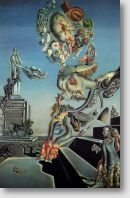As Bataille mentions in the final section of this essay, a sketch of Dali’s painting had to be substituted for a photograph of the actual painting when Dali, under Breton’s influence, withdrew his permission to use the painting in this article. Breton’s animus toward Bataille had intensified earlier in 1929 when several original members of the Surrealist movement refused Breton’s call for collective action and associated themselves, instead, with Bataille’s new periodical, Documents. Breton would express his anger directly in the Second manifeste du surréalisme, which was published in La Révolution surréaliste the same month that Bataille published “Le ‘Jeu lugubre.’”
[Breton’s attack on Bataille is available by clicking here <http://www.mtsu.edu/~jcomas/bataille/breton.html>.]
The editor of Bataille’s Œuvres complètes, Denis Hollier, has compiled a “dossier” of unpublished writing related to Bataille’s feud with Breton; see “Dossier de la polémique avec André Breton” in Vol. II, 51-109.
